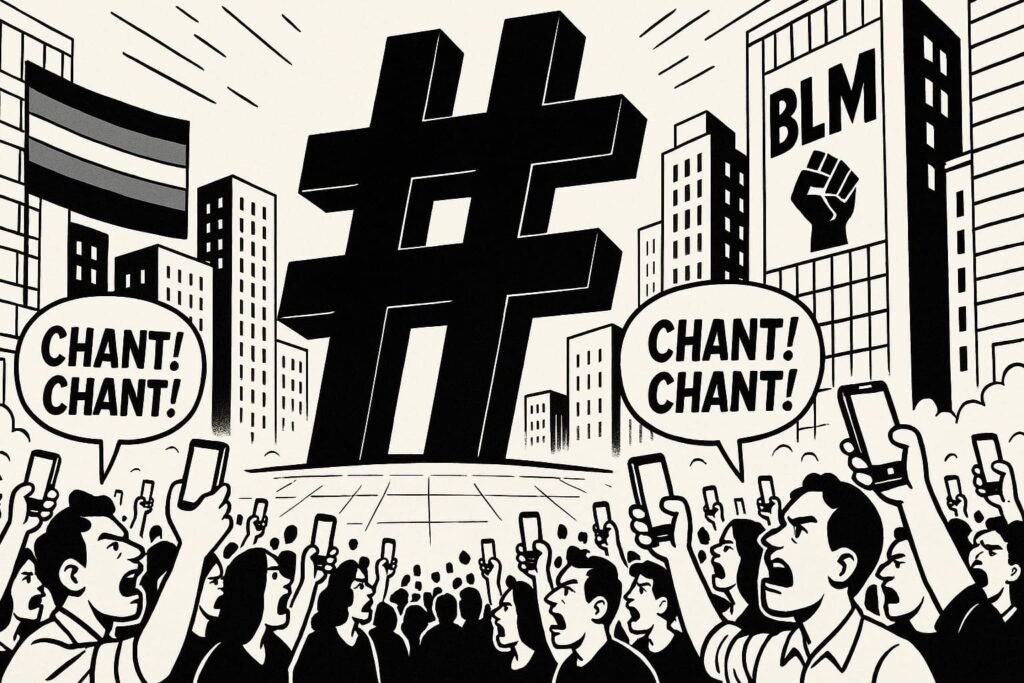Digital Activism Explained – Hashtag and Online Uprisings
It used to take years to organise a protest. Now it takes a hashtag.
From #BLM to #MeToo to #ClimateStrike, the internet turned activism into a frictionless experience. No flyers, no marches, no awkward meetings in church basements — just trending hashtags, viral outrage, and millions of “allies” signing up with a retweet.
The promise: democracy on demand. The reality: attention spans measured in news cycles.
Table of contents
What Is Digital Activism?
Digital activism is the art of turning likes and shares into political leverage. Instead of storming the barricades, you storm the timeline.
The key tool: the hashtag. It connects strangers, amplifies grievances, and pressures institutions to act — or at least look like they’re acting.
How It Shows Up in Practice
- #BlackLivesMatter → a hashtag born in 2013 after Trayvon Martin’s death, supercharged by the George Floyd protests in 2020.
- #MeToo → exploded in 2017 as women shared harassment stories, toppling Hollywood moguls and CEOs.
- #ClimateStrike → Greta Thunberg’s school strike went global thanks to hashtags, inspiring millions of teens to skip class.
- Cancel culture → boycotts and pile-ons organised at lightning speed, all with the ease of a trending tag.
Digital activism is the world’s cheapest megaphone — but also the world’s noisiest echo chamber.
Who Benefits?
- Activists → instant visibility, global reach, no budget required.
- Media outlets → hashtags deliver ready-made storylines and clicks.
- Corporations & politicians → easy virtue-signalling. Change your logo, post a slogan, look “on the right side of history.”
The Consequences
Hashtag activism raised awareness like nothing before — but awareness is not power. Many movements peak online, then fade offline:
- #MeToo ended some careers but changed few laws.
- #BLM raised billions in donations, yet local communities saw little.
- #ClimateStrike inspired speeches, not emissions cuts.
The danger is that outrage becomes performance. You can “fight injustice” without leaving your sofa — but when everyone’s a digital activist, who’s left to do the hard, boring work of change?
Conclusion
Digital activism is the fast food of politics: cheap, addictive, and everywhere. It can topple reputations overnight but rarely builds lasting institutions. The hashtag gives ordinary people a voice — but it also gives elites an easy way to pretend they’re listening.
👉 Want the bigger picture? Explore our full Activism Explainer Hub to see how movements, tactics, and ideologies shape modern politics.
FAQ
What is digital activism?
Using online platforms — especially hashtags — to mobilise support, raise awareness, and pressure institutions.
What are examples of hashtag movements?
#BlackLivesMatter, #MeToo, #ClimateStrike are the most prominent global cases.
Why are hashtag movements effective?
They spread fast, create mass visibility, and shame powerful figures into reacting.
What’s the main weakness of digital activism?
It often stalls at awareness. Viral outrage doesn’t always translate into lasting reforms.
Is digital activism replacing street protest?
Not entirely — it often fuels or amplifies real-world protests, but can’t substitute for them.



